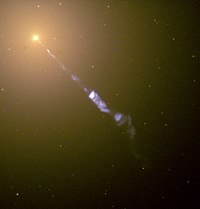Relativistic beaming

Relativistic beaming is when things look different to us depending on how fast they are moving toward or away from us.
Imagine you are standing on a sidewalk watching cars drive by. When a car is coming towards you, it looks bigger and sounds louder. But when it's driving away from you, it looks smaller and sounds quieter. This is because sound waves and light waves are affected by the car's motion.
Now, imagine that instead of watching cars, you are watching stars. Stars are very far away, so they usually look the same size and brightness no matter how fast they are moving. But if a star is moving very fast towards or away from you, it can actually appear brighter and smaller or dimmer and larger. This is called relativistic beaming.
The reason this happens is because of something called the Doppler effect, which is what we talked about with the cars. As objects, like stars, move towards us, the light waves they emit get "squeezed" and become shorter, which means they shift towards the blue end of the spectrum. This makes the star appear bluer and brighter. But if the star moves away from us, the light waves get "stretched" and become longer, which means they shift towards the red end of the spectrum. This makes the star appear redder and dimmer.
Relativistic beaming happens when objects are moving close to the speed of light. At those speeds, the Doppler effect becomes even more extreme and objects can appear much brighter or dimmer than they would otherwise. This is important in astronomy because it helps us understand how objects like black holes and other massive objects in the universe behave.
Imagine you are standing on a sidewalk watching cars drive by. When a car is coming towards you, it looks bigger and sounds louder. But when it's driving away from you, it looks smaller and sounds quieter. This is because sound waves and light waves are affected by the car's motion.
Now, imagine that instead of watching cars, you are watching stars. Stars are very far away, so they usually look the same size and brightness no matter how fast they are moving. But if a star is moving very fast towards or away from you, it can actually appear brighter and smaller or dimmer and larger. This is called relativistic beaming.
The reason this happens is because of something called the Doppler effect, which is what we talked about with the cars. As objects, like stars, move towards us, the light waves they emit get "squeezed" and become shorter, which means they shift towards the blue end of the spectrum. This makes the star appear bluer and brighter. But if the star moves away from us, the light waves get "stretched" and become longer, which means they shift towards the red end of the spectrum. This makes the star appear redder and dimmer.
Relativistic beaming happens when objects are moving close to the speed of light. At those speeds, the Doppler effect becomes even more extreme and objects can appear much brighter or dimmer than they would otherwise. This is important in astronomy because it helps us understand how objects like black holes and other massive objects in the universe behave.
Related topics others have asked about:
